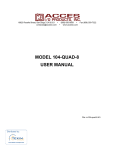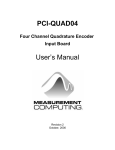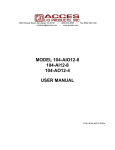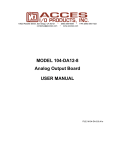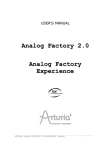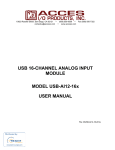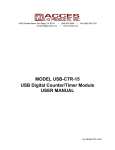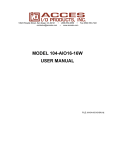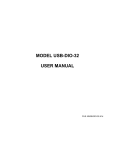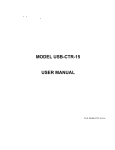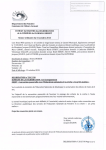Download 104-QUAD-8 User Manual - ACCES I/O Products, Inc.
Transcript
10623 Roselle Street, San Diego, CA 92121 (858) 550-9559 [email protected] www.accesio.com Fax (858) 550-7322 MODEL 104-QUAD-8 MODEL 104-QUAD-4 EIGHT AND FOUR CHANNEL QUADRATURE INPUT PC/104 BOARDS USER MANUAL File: M104-QUAD-8.D1 Notice The information in this document is provided for reference only. ACCES does not assume any liability arising out of the application or use of the information or products described herein. This document may contain or reference information and products protected by copyrights or patents and does not convey any license under the patent rights of ACCES, nor the rights of others. IBM PC, PC/XT, and PC/AT are registered trademarks of the International Business Machines Corporation. Printed in USA. Copyright 2002, 2005 by ACCES I/O Products, Inc. 10623 Roselle Street, San Diego, CA 92121. All rights reserved. WARNING!! ALWAYS CONNECT AND DISCONNECT YOUR FIELD CABLING WITH THE COMPUTER POWER OFF. ALWAYS TURN COMPUTER POWER OFF BEFORE INSTALLING A BOARD. CONNECTING AND DISCONNECTING CABLES, OR INSTALLING BOARDS INTO A SYSTEM WITH THE COMPUTER OR FIELD POWER ON MAY CAUSE DAMAGE TO THE I/O BOARD AND WILL VOID ALL WARRANTIES, IMPLIED OR EXPRESSED. 2 Manual 104-QUAD-8 Warranty Prior to shipment, ACCES equipment is thoroughly inspected and tested to applicable specifications. However, should equipment failure occur, ACCES assures its customers that prompt service and support will be available. All equipment originally manufactured by ACCES which is found to be defective will be repaired or replaced subject to the following considerations. Terms and Conditions If a unit is suspected of failure, contact ACCES' Customer Service department. Be prepared to give the unit model number, serial number, and a description of the failure symptom(s). We may suggest some simple tests to confirm the failure. We will assign a Return Material Authorization (RMA) number which must appear on the outer label of the return package. All units/components should be properly packed for handling and returned with freight prepaid to the ACCES designated Service Center, and will be returned to the customer's/user's site freight prepaid and invoiced. Coverage First Three Years: Returned unit/part will be repaired and/or replaced at ACCES option with no charge for labor or parts not excluded by warranty. Warranty commences with equipment shipment. Following Years: Throughout your equipment's lifetime, ACCES stands ready to provide on-site or in-plant service at reasonable rates similar to those of other manufacturers in the industry. Equipment Not Manufactured by ACCES Equipment provided but not manufactured by ACCES is warranted and will be repaired according to the terms and conditions of the respective equipment manufacturer's warranty. General Under this Warranty, liability of ACCES is limited to replacing, repairing or issuing credit (at ACCES discretion) for any products which are proved to be defective during the warranty period. In no case is ACCES liable for consequential or special damage arriving from use or misuse of our product. The customer is responsible for all charges caused by modifications or additions to ACCES equipment not approved in writing by ACCES or, if in ACCES opinion the equipment has been subjected to abnormal use. "Abnormal use" for purposes of this warranty is defined as any use to which the equipment is exposed other than that use specified or intended as evidenced by purchase or sales representation. Other than the above, no other warranty, expressed or implied, shall apply to any and all such equipment furnished or sold by ACCES. 3 Manual 104-QUAD-8 TABLE OF CONTENTS Chapter 1: Introduction ..............................................................................................................5 Features ................................................................................................................................................................... 5 Applications ............................................................................................................................................................ 5 Functional Description ........................................................................................................................................... 5 Figure 1-1: Block Diagram .................................................................................................................................. 6 Ordering Guide ....................................................................................................................................................... 6 Model Options ......................................................................................................................................................... 6 Included with your board ....................................................................................................................................... 7 Optional Accessories ............................................................................................................................................. 7 Chapter 2: Installation ................................................................................................................8 CD Installation......................................................................................................................................................... 8 DOS ...................................................................................................................................................................... 8 WINDOWS ........................................................................................................................................................... 8 LINUX ................................................................................................................................................................... 8 Installing the Hardware .......................................................................................................................................... 9 To Install the Board ................................................................................................................................................ 9 Figure 2-1: PC/104 Key Information.................................................................................................................... 9 Chapter 3: Option Selection ....................................................................................................10 Figure 3-1: Setup Configuration Map ................................................................................................................ 10 Chapter 4: Address Selection ..................................................................................................11 Table 4-1: Hex Ranges ...................................................................................................................................... 11 Table 4-2: Hex Conversion Table ...................................................................................................................... 12 Chapter 5: Programming ..........................................................................................................13 Table 5-1: Base Address Map ........................................................................................................................... 13 Data Registers (0, 2, 4, 8, A, C, E)h: .................................................................................................................... 14 Control Registers (1, 3, 5, 7, 9, B, D, F)h: ........................................................................................................... 14 Reading the FLAG Register: ................................................................................................................................ 14 Writing to the RLD (Reset and Load Signal Decoders): ................................................................................... 15 Writing to the CMR (Counter Mode Register): ................................................................................................... 15 Writing to the IOR (Input / Output Control Register): ....................................................................................... 15 Writing to the IDR (Index Control Register): ...................................................................................................... 16 Working with Interrupts: ...................................................................................................................................... 16 Reading the Interrupt Status Register (10h) ...................................................................................................... 16 Writing to the Channel Operation Register (11h) .............................................................................................. 16 Writing to the Index / Interrupt Register (12h) ................................................................................................... 17 Selecting the Slow Filter Clock (13h) (Optional) ............................................................................................... 17 Selecting the Fast Filter Clock (14h) (Optional) ................................................................................................ 17 Reading Index Input Levels (16h) ....................................................................................................................... 17 Reading Differential Encoder Cable Status (17h) .............................................................................................. 17 Reading the CPLD Revision Register (18h) ....................................................................................................... 17 Sample Code (C:DOS / debug.exe) ..................................................................................................................... 18 Chapter 6: Connector Pin Assignments .................................................................................19 Table 6-1: Connector Pin Assignments - P2 .................................................................................................... 19 Table 6-2: Connector Pin Assignments - P3 .................................................................................................... 20 Chapter 7: Specification ...........................................................................................................21 Customer Comments ...............................................................................................................22 4 Manual 104-QUAD-8 Chapter 1: Introduction Features Up to eight quadrature encoders may be connected Input conditioning per channel allows a variety of encoder types to be used Interrupt for an encoder index is program enabled per channel Outputs to computer can include count, direction of movement 24 bit counters for each input channel +5V supply available to the user Applications Automatic Test Systems Laboratory Automation Robotics Machine Control Security Systems Energy Management Functional Description The card is a general purpose Quadrature Encoder Counter/Interface board. It is provided in the popular PC/104 format and conditions and monitors the outputs of 8 encoders. Available functions include anything that can be programmed into the versatile LSI/CSI LS7266R1 integrated circuit. Core functions handled by the LS7266R1 includes direction and total count. By performing these functions on-board, it frees the computer for higher level applications. The ability to provide an interrupt for the index frees the computer from the necessity of constantly reading the position of an encoder. Interrupts are directed to levels #2 through #7, #10 through #12, and #15 by jumper installation. The card is designed for industrial applications. Each input line is buffered and capable of accepting inputs up to 6 volts. A +5 Volt source is available to provide power for many encoder types. The conditioned inputs are connected to associated LSI/CSI LS7266R1 integrated circuits. These circuits are the heart of the card’s operation. We strongly recommend reviewing the manufacturer’s data sheet for detailed information. The card occupies 32 bytes of I/O address space. The base address is selectable via jumpers anywhere within the range of 100-3E0 hex. An illustrated setup program is provided with the card. Interactive displays show locations and proper settings of jumpers to set up board address and interrupt levels. 5 Manual 104-QUAD-8 SPECIAL NOTE FOR PROGRAMMERS: The language not recommended for programming interrupt service routines is any version of Visual BASIC. The recommended programming languages for IRQ based applications are Delphi and C++ Builder. Figure 1-1: Block Diagram Ordering Guide 104-QUAD-8 104-QUAD-4 Eight-channel quadrature decoder PC/104 board Four-channel quadrature decoder PC/104 board Model Options -T -F Extended operating temperature of -40 to +85C Higher frequency FCK of 33.300 MHz -DF Differential filter of 120Ω in series with 4700pF per channel. -RoHS This product is available in a RoHS compliant version. Please call for specific pricing then be sure to add this suffix to the model number on any hard-copy or verbal purchase orders. 6 Manual 104-QUAD-8 Included with your board The following components are included with your shipment, depending on options ordered. Please take the time now to ensure that no items are damaged or missing. PC/104 quadrature board Software Master CD Quick-Start Guide Optional Accessories C104-34F-12 STB-34 DIN-SNAP6 104-HDW-KIT(x) Ribbon cable assembly, 12” with 34 pin female headers on each end Screw terminal board, 34 pin male header DIN-rail mounting for one STB-34 PC/104 mounting hardware kit includes standard 4/40 (x=S for standard), (x=M for metric) standoffs and pan-head phillip screws for securing into PC/104 stack 7 Manual 104-QUAD-8 Chapter 2: Installation A printed Quick-Start Guide (QSG) is packed with the board for your convenience. If you’ve already performed the steps from the QSG, you may find this chapter to be redundant and may skip forward to begin developing your application. The software provided with this PC/104 Board is on CD and must be installed onto your hard disk prior to use. To do this, perform the following steps as appropriate for your operating system. Substitute the appropriate drive letter for your CD-ROM where you see d: in the examples below. CD Installation The following instructions assume the CD-ROM drive is drive “D”. Please substitute the appropriate drive letter for your system as necessary. DOS 1. 2. 3. 4. Place the CD into your CD-ROM drive. Type to change the active drive to the CD-ROM drive. Type to run the install program. Follow the on-screen prompts to install the software for this board. WINDOWS 1. 2. 3. Place the CD into your CD-ROM drive. The system should automatically run the install program. If the install program does not run promptly, click START | RUN and type , click OK or press . Follow the on-screen prompts to install the software for this board. LINUX 1. Please refer to linux.htm on the CD-ROM for information on installing under linux. 8 Manual 104-QUAD-8 Installing the Hardware Before installing the board, carefully read Chapter 3 and Chapter 4 of this manual and configure the board according to your requirements. The SETUP Program can be used to assist in configuring jumpers on the board. Be especially careful with Address Selection. If the addresses of two installed functions overlap, you will experience unpredictable computer behavior. To help avoid this problem, refer to the FINDBASE.EXE program installed from the CD. The setup program does not set the options on the board, these must be set by jumpers. To Install the Board 1. 2. 3. 4. 5. 6. 7. Install jumpers for selected options and base address according to your application requirements, as mentioned above. Remove power from the PC/104 stack. Assemble standoff hardware for stacking and securing the boards. Carefully plug the board onto the PC/104 connector on the CPU or onto the stack, ensuring proper alignment of the pins before completely seating the connectors together. Install I/O cables onto the board’s I/O connectors and proceed to secure the stack together or repeat steps 3-5 until all boards are installed using the selected mounting hardware. Check that all connections in your PC/104 stack are correct and secure then power up the system. Run one of the provided sample programs appropriate for your operating system that was installed from the CD to test and validate your installation. Figure 2-1: PC/104 Key Information 9 Manual 104-QUAD-8 Chapter 3: Option Selection The only selections necessary to setup on the card are the IRQ level and the card’s base address. All other features are setup via software. Interrupts are directed to levels #2 through #7, #10 through #12, and #15 by a jumper at locations labeled IRQ2 through IRQ7, IRQ10 through IRQ12, and IRQ15. Figure 3-1: Setup Configuration Map 10 Manual 104-QUAD-8 Chapter 4: Address Selection The card occupies 32 bytes of I/O space. The card base address can be selected anywhere within the I/O address range 100-3E0 hex. If in doubt of where to assign the base address, refer to the table below and the FINDBASE program. HEX RANGE 000-00F 020-021 040-043 060-06F 070-07F 080-09F 0A0-0BF 0C0-0DF 0F0-0F1 0F8-0FF 170-177 1F0-1F8 200-207 238-23B 23C-23F 278-27F 2B0-2BF 2C0-2CF 2D0-2DF 2E0-2E7 2E8-2EF 2F8-2FF 300-30F 310-31F 320-32F 370-377 378-37F 380-38F 3A0-3AF 3B0-3BB 3BC-3BF 3C0-3CF 3D0-3DF 3E8-3EF 3F0-3F7 3F8-3FF USAGE 8237 DMA Controller 1 8259 Interrupt 8253 Timer 8042 Keyboard Controller CMOS RAM, NMI Mask Reg, RT Clock DMA Page Register 8259 Slave Interrupt Controller 8237 DMA Controller 2 Math Coprocessor Math Coprocessor Fixed Disk Controller 2 Fixed Disk Controller 1 Game Port Bus Mouse Alt. Bus Mouse Parallel Printer EGA EGA EGA GPIB (AT) Serial Port Serial Port Hard Disk (XT) Floppy Controller 2 Parallel Printer SDLC SDLC MDA Parallel Printer VGA EGA CGA Serial Port Floppy Controller 1 Serial Port Table 4-1: Hex Ranges 11 Manual 104-QUAD-8 The board’s base address is set up by JUMPERS. Those jumpers control address bits A5 through A9. (Lines A4, A3, A2, A1 and A0 are used on the board to control individual registers. How these four lines are used is described in the Programming section of this manual.) To determine how to set these JUMPERS for a desired hex-code address, refer to the SETUP program provided with the board. If you prefer to determine proper jumper settings yourself, first convert the hexcode address to binary form. Then, for each "0", install corresponding jumpers and for each "1", remove the corresponding jumper. The following example illustrates jumper selection corresponding to hex 300 (or binary 11 000x xxxx). The "x xxxx" represents address lines A4, A3, A2, A1, and A0 used on the board to select individual registers as described in the Programming section of this manual. Base Address in Hex Code 3 0 Conversion Factors 2 1 8 4 2 Binary Representation 1 1 0 0 0 Jumper Legend A9 A8 A7 A6 A5 Addr. Line Controlled A9 A8 A7 A6 A5 Jumper Selection OFF OFF ON ON ON Table 4-2: Hex Conversion Table Carefully review the address selection reference table on the preceding page before selecting the board address. If the addresses of two installed functions overlap, you will experience unpredictable computer behavior. 12 Manual 104-QUAD-8 Chapter 5: Programming The card is an I/O-mapped device that is easily configured from any language and any language can easily perform quadrature reads. This is especially true if the form of the data is byte or word wide. All references to the I/O ports would be in absolute port addressing. However, a table could be used to convert the byte or word data ports to a logical reference. Please refer to the chip-specification for the LS7266R1 in addition to this user manual for guidance and information helpful to write device drivers for it (this spec sheet is on the software CD located in “ChipDocs”), Also, the source code for Windows shows how to write device drivers for this product. Address Port Assignment Operation Base Address Channel 1 Data Read/Write Base Address +1 Channel 1 Flag / Command Read/Write Base Address +2 Channel 2 Data Read/Write Base Address +3 Channel 2 Flag / Command Read/Write Base Address +4 Channel 3 Data Read/Write Base Address +5 Channel 3 Flag / Command Read/Write Base Address +6 Channel 4 Data Read/Write Base Address +7 Channel 4 Flag / Command Read/Write Base Address +8 Channel 5 Data Read/Write Base Address +9 Channel 5 Flag / Command Read/Write Base Address +A Channel 6 Data Read/Write Base Address +B Channel 6 Flag / Command Read/Write Base Address +C Channel 7 Data Read/Write Base Address +D Channel 7 Flag / Command Read/Write Base Address +E Channel 8 Data Read/Write Base Address +F Channel 8 Flag / Command Read/Write Base Address +10 Interrupt Status Register Read Only Base Address +11 Channel Operation Register Read/Write Base Address +12 Index/Interrupt Register Read/Write Base Address +13 (Optional) Select 130.078 kHz FCK Write Only Base Address +14 (Optional) Select 33.300 MHz FCK Write Only Base Address +15 Reserved for Factory Use N/A Base Address +16 Index Input Levels Read Only Base Address +17 Differential Encoder Cable Status Read/Write Base Address +18 CPLD Revision Read Only Base Address +19 through +1F Reserved for Factory Use N/A Device First LS7266R1 Second LS7266R1 Third LS7266R1 Fourth LS7266R1 CPLD Table 5-1: Base Address Map 13 Manual 104-QUAD-8 Data Registers (0, 2, 4, 8, A, C, E)h: These registers are read to retrieve the current count from the channel, and written to set the Preset Register and the Filter Clock Prescalers. To get the count from Channel 1 (Data register 0) you would first write 11h to the control register at address 1. Three reads are then required to get the current count from data register 0. The first read returns the Least Significant Byte and the last read returns the Most Significant Byte. In order to write to the Preset Register first write 11h to the control register. Then perform three writes to the data register. The first write is the Least Significant Byte, and the last write is the Most Significant Byte. In order to write to the Filter Clock Prescaler first write 11h to the control register. Then write one byte to the data register with the desired PSC value. Then write 19h to the control register. Control Registers (1, 3, 5, 7, 9, B, D, F)h: The control registers all correspond to the data register that is one address below it. The control register is used for the following operations: Reading the Flag Register; Resetting the BP (three byte data pointer) and flags; Setting the PSC (filter clock factor n) and PR (preset count); Initial setup of the Counter Mode Register, Input/Output Control Register and Index Control Register. Reading the FLAG Register: Bit 0 BT: Borrow Toggle flip-flop. Toggles every time the counter underflows. Bit 1 CT: Carry Toggle flip-flop. Toggles every time the counter overflows. Bit 2 CPT : Compare Toggle flip-flop. Toggles every time the counter is equal to the Preset Register. Bit 3 S: Sign flag. Set to 1 when counter underflows and reset to 0 when it overflows. Bit 4 E: Error flag. Set to 1 when excessive noise is present at the count inputs in quadrature mode. Ignore in other modes. Bit 5 U/D: Up/Down flag. Set to 1 when counting up and reset to 0 when counting down. Bit 6 IDX: Index. Set to 1 when selected index input is at active level. Bit 7: Not used is always 0. 14 Manual 104-QUAD-8 Writing to the RLD (Reset and Load Signal Decoders): Bit 0: 1 to reset BP. Bits 1 & 2: Set bit 1 high to reset CNTR, set bit 2 high to reset BT, CT, CPT, S flags. Set both bits high to reset E flag. Bits 3 & 4: Set bit 3 high to transfer Preset Register to Counter. Set bit 4 high to transfer CNTR to Output Latch. Set both high to transfer Preset Register LSB to the PSC (FCK Prescaler). Bits 5 & 6: Set both bits to 0. Bit 7: Set high to program both counters simultaneously. Writing to the CMR (Counter Mode Register): Bit 0: Set low to use Binary count, and set high to use BCD count. Bits 1 & 2: Set both low to use Normal count. Set bit 1 high to use Range Limit. Set bit 2 high to use Non-Recycle count. Set both bits high to use Modulo-N count. Bits 3 & 4: Set both bits low to use non-quadrature mode. Set bit 3 high to use Quadrature times 1. Set bit 4 high to use Quadrature times 2. Set both bits high to use Quadrature times 4. Bits 5 & 6: Set bit 5 high and bit 6 low. Bit 7: Set high to program both counters simultaneously. Writing to the IOR (Input / Output Control Register): Bit 0: Set high to enable A and B inputs. Bit 1: Set low to preset count when Index occurs. Set high to continuously count. Bit 2: Set low. Bits 3 & 4: Set both bits low to use FLG1 as /Carry (active low). Set bit 3 high to use FLG1 as /Compare (active low). Set bit 4 high to use FLG1 as /Carry/Borrow (active low). Set both bits high to use FLG1 as Index (active high). Bits 5 & 6: Set bit 5 low and bit 6 high. Bit 7: Set high to program both counters simultaneously. Note that when Interrupts are enabled on the card they occur whenever FLG1 is active. 15 Manual 104-QUAD-8 Writing to the IDR (Index Control Register): Bit 0: Set high to enable index. Bit 1: Set high for a positive index polarity. Set low for a negative index polarity. Bit 2: Set low. Bits 3 & 4: Not used. Bits 5 & 6: Set high. Bit 7: Set high to program both counters simultaneously. Working with Interrupts: Reading the Interrupt Status Register (10h) When an interrupt occurs read from address 10h to determine which channel was the source. Bit 0-7: The Least Significant Bit will correspond to the first channel. High = true Writing to the Channel Operation Register (11h) Any write to this address will clear any pending interrupts. A read from this address will return it’s contents. Bit 0: Set high to reset all Counters. Set low to enable all Counters. Bit 1: Reserved. Bit 2: Set low to disable the interrupt function. Set high to enable the interrupt function. Bits 3-7: Reserved. 16 Manual 104-QUAD-8 Writing to the Index / Interrupt Register (12h) This register is used to Preset Counter via the LCNTR input pin when a channel index occurs as described in Writing to the IOR and Writing to the IDR. Additionally it is used to generate interrupts whenever FLG1 on a channel is active as described in Writing to the IOR and Writing to the Channel Operation Register. Each bit of this register enables / disables a corresponding channel. A read from this address will return it’s contents. Bit 0: Bit 1: Bit 2: Bit 3: Bit 4: Bit 5: Bit 6: Bit 7: Set high to enable Channel 1 Set high to enable Channel 2 Set high to enable Channel 3 Set high to enable Channel 4 Set high to enable Channel 5 Set high to enable Channel 6 Set high to enable Channel 7 Set high to enable Channel 8 Selecting the Slow Filter Clock (13h) (Optional) Select 130.078 kHz FCK by writing any value to this address. Selecting the Fast Filter Clock (14h) (Optional) Select 33.300 MHz FCK by writing any value to this address (default). *14.318 MHz is the Filter Clock frequency without the “-F” fast FCK factory option. Reading Index Input Levels (16h) Bit 0 through 7 correspond to channels 1 through 8. Logic 0 = Index Input low (false). Logic 1 = Index Input high (true). *If your encoder does not have an Index signal, the Index Positive Input pin needs to be grounded or the corresponding channel bit will return a logic 1 level. Reading Differential Encoder Cable Status (17h) Bit 0 through 7 correspond to channels 1 through 8. To enable any channel write a 0 to the corresponding bit. When enabled, Logic 0 = cable fault (not connected or loose wires). Logic 1 = cable connection good or cable fault disabled (default). Bits 0 through 7 will always read a high when disabled. Reading the CPLD Revision Register (18h) To determine the CPLD Revision read from address 18h Old card revisions B10 and earlier will read FF Revision C1 cards will read 00 Revision C2 cards will read 01 17 Manual 104-QUAD-8 Sample Code (C:DOS / debug.exe) Channel 1 setup o 301 15 o 300 00 o 300 00 o 300 00 o 301 28 o 301 59 o 301 63 o 311 05 o 311 04 o 312 01 Channel 1 data (24-bit) and flags (8-bit), card interrupt status (8-bit) o 301 11 i 300 i 300 i 300 i 301 i 310 o 311 04 repeat above 7 commands while turning encoder 18 Manual 104-QUAD-8 Chapter 6: Connector Pin Assignments Function Ground Index Negative Input Quadrature A Negative Input Quadrature B Negative Input Ground Index Negative Input Quadrature A Negative Input Quadrature B Negative Input Ground Index Negative Input Quadrature A Negative Input Quadrature B Negative Input Ground Index Negative Input Quadrature A Negative Input Quadrature B Negative Input No connection CH# 1 1 1 1 2 2 2 2 3 3 3 3 4 4 4 4 Pin 1 3 5 7 9 11 13 15 17 19 21 23 25 27 29 31 33 Pin CH# Function 2 1 Fused +5V 4 1 Index Positive Input 6 1 Quadrature A Positive Input 8 1 Quadrature B Positive Input 10 2 Fused +5V 12 2 Index Positive Input 14 2 Quadrature A Positive Input 16 2 Quadrature B Positive Input 18 3 Fused +5V 20 3 Index Positive Input 22 3 Quadrature A Positive Input 24 3 Quadrature B Positive Input 26 4 Fused +5V 28 4 Index Positive Input 30 4 Quadrature A Positive Input 32 4 Quadrature B Positive Input 34 No connection Table 6-1: Connector Pin Assignments - P2 Notes: 1. When using single-ended Encoders leave the Negative Input open (internal 2.5V bias level) and connect the Encoder (A, B, Index) output lead to the corresponding Positive Input pin. 2. Both single-ended and differential Encoders require a ground connection between the Encoder and the PC/104 board to eliminate the adverse effects of exceeding the common mode range. 3. If your encoder does not have an index signal, the Index Positive Input pin needs to be grounded. 19 Manual 104-QUAD-8 Function Ground Index Negative Input Quadrature A Negative Input Quadrature B Negative Input Ground Index Negative Input Quadrature A Negative Input Quadrature B Negative Input Ground Index Negative Input Quadrature A Negative Input Quadrature B Negative Input Ground Index Negative Input Quadrature A Negative Input Quadrature B Negative Input No connection CH# 5 5 5 5 6 6 6 6 7 7 7 7 8 8 8 8 Pin 1 3 5 7 9 11 13 15 17 19 21 23 25 27 29 31 33 Pin CH# Function 2 5 Fused +5V 4 5 Index Positive Input 6 5 Quadrature A Positive Input 8 5 Quadrature B Positive Input 10 6 Fused +5V 12 6 Index Positive Input 14 6 Quadrature A Positive Input 16 6 Quadrature B Positive Input 18 7 Fused +5V 20 7 Index Positive Input 22 7 Quadrature A Positive Input 24 7 Quadrature B Positive Input 26 8 Fused +5V 28 8 Index Positive Input 30 8 Quadrature A Positive Input 32 8 Quadrature B Positive Input 34 No connection Table 6-2: Connector Pin Assignments - P3 Notes: 1. When using single-ended Encoders leave the Negative Input open and connect the Encoder (A, B, Index) output lead to the corresponding Positive Input pin. 2. Both single-ended and differential Encoders require a ground connection between the Encoder and the PC/104 board to eliminate the adverse effects of exceeding the common mode range. 3. If your encoder does not have an index signal, the Index Positive Input pin needs to be grounded. 20 Manual 104-QUAD-8 Chapter 7: Specification Power Consumption + 5 Volts + 5 V Fused Outputs 260mA (typical, no load on +5V fused output pins) Two 0.5A Resettable fuses Input Section Receiver Type Configuration per Encoder Number of Channels Common mode input range Differential Input Range Sensitivity Hysteresis Impedance Bias Options AM26LS32 Phase A, Phase B and Index as Differential Pairs 8 +/- 7 V maximum +/- 25 V maximum Differential voltage values are at the noninverting (A) input terminals with respect to the inverting (B) input terminals. +/- 200 mV 50 mV typical 12 kΩ minimum (Positive pins) +5V via 4.7kΩ pull ups (Negative pins) +2.5V via pull up/down combo Differential filter 120Ω in series with 4700pF Counter Section Counter Type: Quadrature Clock Frequency Quadrature Separation Quadrature Clock Pulse Width Index Pulse width Filter Clock (FCK) LS7266R1 24 bit Dual Axis Quadrature Counter 4.3 MHz maximum 57 ns min 115 ns min 85 ns min PC/104 Bus OSC 14.318 MHz (Optional 33.300 MHz oscillator available) Interrupt Controller Section Controller Type Interrupts Interrupt Sources Addressing Environmental Operating Temperature: Storage Temperature: Humidity: CPLD Jumper selectable (2-7,10-12,15) FLG1 outputs from LS7266R1s ISA bus address is set by jumpers (100-3E0h) 0 C to +70 C (optional -40 C to +85 C) -50 C to +120 C up to 95% RH, non-condensing 21 Manual 104-QUAD-8 Customer Comments If you experience any problems with this manual or just want to give us some feedback, please email us at: [email protected]. Please detail any errors you find and include your mailing address so that we can send you any manual updates. 10623 Roselle Street, San Diego CA 92121 Tel. (858)550-9559 FAX (858)550-7322 www.accesio.com 22 Manual 104-QUAD-8






















